Youtube Canon Ef 24105 F3556 Is Lens Review
Canon EF-S 18-135mm f/3.5-5.vi IS USM Lens Review

The EF-South xviii-135mm f/3.v-5.6 IS USM Lens is attractive on many fronts, including its wide (seven.5x) focal length range, its relatively small size and light weight, its fast, shine and accurate autofocusing, its great functionality including epitome stabilization and its small cost.
This is Catechism'southward third iteration of the EF-S 18-135mm image stabilized lens. The commencement model featured a cost-constructive DC motor. The 2nd generation received a stepping motor, producing polish and very quiet focus acquisition and tracking that was ideal for Pic Servo AF. The latest lens receives Ring USM-driven AF.
Seeing "USM" (Ultrasonic Motor) in the lens name seems very common for those of us using Catechism lenses and nosotros normally count on very fast focusing driven by a Band-USM variant. Simply, this Ring USM is like no other nosotros've seen before. The EF-S 18-135mm USM has Canon's beginning Nano-USM AF motor implementation, promising us the silence and smoothness of STM with considerably faster AF drive. Read on to learn more about this feature.
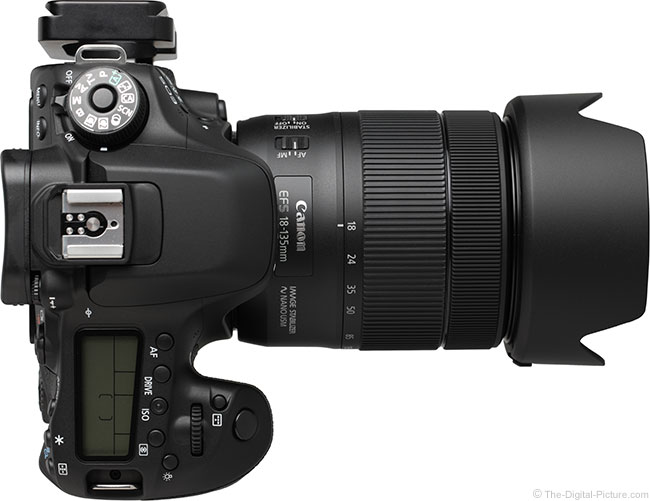
Focal Length / Focal Length Range
Narrowing down the focal length or focal length range platonic for your photographic needs is the first benchmark for lens selection. The focal length chosen for a particular image determines the distance required for proper framing and in turn, the perspective. At that place are times when the platonic subject distance cannot be obtained, perhaps due to an obstruction (such as a wall), and in those cases, having a zoom range to work with permits ideal subject framing from the discipline altitude bachelor to you.
The focal length range of this lens is a hugely valuable asset.
As an "EF-S" lens, the xviii-135 IS USM is only compatible with Canon APS-C format cameras. permitting APS-C-only "EF-S" lenses to be smaller, lighter and less expensive relative to their full frame lens counterparts (which remain compatible with the APS-C cameras). With a smaller imaging sensor than full frame models, APS-C format cameras practice not require the larger paradigm circumvolve projected by full frame compatible lenses, permitting APS-C-simply "EF-S" lenses to be smaller, lighter and less expensive to manufacture relative to their full frame lens counterparts (which remain uniform with the APS-C cameras).
Using a smaller prototype circle ways that APS-C sensor format cameras frame a scene more tightly, with 1.6x being the multiplier (FOVCF) used to determine the full frame angle of view equivalent. Multiplying 18-135mm by 1.6x yields 28.8-216mm, the full frame 35mm format photographic camera angle of view equivalent for this lens.
The list of uses for these focal lengths is as long as the focal length range itself. Even if I had the time to create a comprehensive list of uses for this wide general purpose focal length range, you would not likely have the time or interest to read information technology. Only, I'll become you lot started with some ideas.
For sure is that this is an excellent travel lens. When traveling, especially when not driving yourself to the location, your luggage size and weight is probable limited. Fewer lenses with smaller size and weights make conforming to these requirements easier. Also, traveling frequently involves spending lots of time with a camera in mitt. The aforementioned reasons make this use less tiring and more than pleasant.

A superb ready of portrait focal lengths are congenital into this lens, including the much-acclaimed 85-135mm (full frame angle of view equivalent) range. The ideal focal lengths are provided for total body portraits (29mm was used for the in a higher place prototype) through tight head shots. Preserving family unit memories can be fully accommodated by these focal lengths.
While I prefer a lens that zooms out to a 24mm bending of view equivalent (15mm) if landscape photography is on my to-exercise listing, the 29mm equivalent bending of view (at 18mm) will take in moderately wide views of nature. And, the rest of the focal lengths included in this lens are all very useful for landscape photography.
The video uses for this focal length range are similar as for notwithstanding photos.
For an example of what this focal length range looks like, we caput below the Ben Franklin Bridge in New Bailiwick of jersey and view the Philadelphia skyline beneath information technology.

If you are considering a lens with 50mm or similar at the long finish, specifically compare the 50mm focal length to 135mm. The difference is dramatic – the extra length is really nice to have without a lens change required.

Max Aperture
The f/iii.5-5.six in the lens name refers to the lens' max aperture opening, the human relationship of the lens opening (diaphragm) to focal length. The lower the number, the more light the lens will allow to achieve the sensor. Each "terminate" in discontinuity change (examples: f/2.8, f/four.0, f/five.half-dozen, f/viii, f/11) increases or reduces the corporeality of lite reaching the sensor by a gene of 2x (a large deal).
Because aperture is measured as a ratio of lens opening to focal length and considering this lens has a (basically) abiding maximum opening, this lens has a variable max aperture. As the focal length increases, the maximum opening size does not appreciably increase, resulting in aperture measurements stepping downward. Here is a chart showing the specific focal lengths where this happens along with the same information for a selection of other lenses.
| Model | f/3.v | f/four.0 | f/4.5 | f/5.0 | f/5.six |
| Canon EF-Due south 15-85mm f/3.5-v.6 IS Lens | 15mm | 18mm | 27mm | 38mm | 61mm |
| Canon EF-Due south 17-85mm f/four-5.half dozen IS Lens | 17mm | 26mm | 38mm | 47mm | |
| Canon EF-S 18-55mm f/three.5-5.half dozen IS STM Lens | 18mm | 24mm | 32mm | 37mm | 47mm |
| Canon EF-South eighteen-135mm f/iii.5-5.6 IS USM Lens | 18mm | 24mm | 35mm | 50mm | 76mm |
| Canon EF-S 18-135mm f/3.5-v.vi IS STM Lens | 18mm | 24mm | 35mm | 50mm | 76mm |
| Canon EF-Southward 18-200mm f/three.five-five.6 IS Lens | 18mm | 24mm | 40mm | 50mm | 90mm |
| Catechism EF 24-105mm f/3.v-5.vi IS STM Lens | 24mm | 28mm | 42mm | 50mm | 67mm |
If your lens is missing from this listing, head over to the full Canon EF-S eighteen-135mm f/3.v-5.half dozen IS USM Lens specifications with the site's Lens Spec tool enabling far more comparisons.
While the step-downs occur in 1/3 cease increments, somewhat unusual is the f/5 aperture remains selected when the discontinuity is inverse past one click at 50mm. Catechism's software calls the bodily discontinuity f/5.0 for both clicks, just Adobe Bridge indicates that the "Max Aperture Value" (max available) is f/4.viii. This is but a very minor business organization, only I encountered it frequently when testing at 50mm.
Assuasive more light to reach the sensor permits freezing action and handholding the camera in lower light levels and can as well permit use of lower (less noisy) ISO settings. In addition to allowing more light to achieve the sensor, increasing the opening permits a stronger, subject-isolating background blur (at equivalent focal lengths). Lenses with an opening to at least a specific aperture (usually f/2.8) enable the higher precision AF capabilities (most oft the eye AF point) in some cameras and present a brighter viewfinder epitome. Another benefit, peculiarly when shooting in Transmission exposure mode, is that constant max aperture lenses permit that max aperture to be set and remain constant regardless of the focal length selected.
The advantages to a narrow discontinuity, because the size of the lens elements can exist reduced significantly in size, include smaller size, lighter weight and lower cost. Those are 3 things that nosotros all tin appreciate.
Relative to the max aperture bachelor in other lenses, the Catechism EF-S 18-135mm f/3.5-5.6 IS USM Lens is relatively "slow", with few other lenses having narrower max apertures. However, many are nearly-equivalents and this max aperture range is not unusual, particularly for non-professional lenses. Withal, this would not exist my kickoff choice lens for indoor sports and similar.
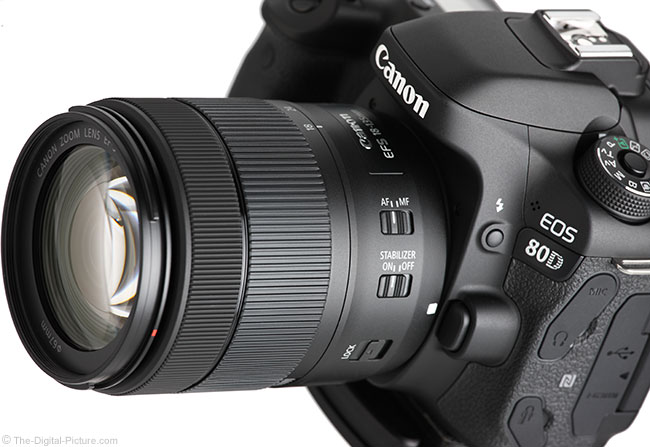
Paradigm Stabilization
While this lens does non have the widest apertures available, prototype stabilization aids in handholding the photographic camera in lower low-cal levels and enables lower ISO settings to be used. When IS is in use, longer handheld exposures can be used without camera motion blur showing in the paradigm. Stabilizing the image does nothing to slow a subject in motion, so IS does not assist in freezing subject area movement in a movie.
When the shutter is half-pressed, Live View is started or Video Mode is entered, the EF-S eighteen-135 USM's IS organisation goes into action. Fortunately, the merely hint to IS existence agile is the paradigm becoming very noticeably more notwithstanding, making ideal subject framing easier. This is one of the quietest IS systems bachelor. It is practically silent with just very light clicking and humming heard with an ear immediately next to lens. Different some stabilization implementations, the paradigm does not bounce in the viewfinder even on startup and shutdown, and the epitome remains stable even with the photographic camera existence moved around (important for video recording).
If the camera is held very still (nearly tripod-steady such as when braced against something stationary), some framing drift tin can be seen. That is reason alone to plough IS off when shooting from a tripod.
Canon rates this IS implementation for 4 stops of assistance, pregnant the lens tin can be handheld in 16x lower calorie-free levels than without IS. Your results will vary greatly depending on a variety of factors affecting your ability to agree the camera steady during the exposure, including wind, basis stability, country of relaxation, skill, etc. As well, your tolerance for keeper rate per centum comes into play. If you don't mind taking 20 photos to insure that 1 sharp image is captured, y'all can employ this lens nether lower light levels than someone who requires every frame to be sharp.
Under controlled (favorable) examination conditions, I could handhold the EF-Southward 18-135 USM lens at 18mm with a high keeper percentage at 1/four 2nd shutter speeds, representing nigh 3 stops of assistance for me. At ane/4 2d I hit a wall on this day, with a very low keeper rate at longer exposures.
At 135mm, I had a near perfect set at 1/15 of a 2nd, representing but under 4 stops of assistance for me. At this focal length, the keeper charge per unit slowly declined as exposure times increased with precipitous images captured even at 1/v 2d.
I find prototype stabilization to be a keen feature on any lens, but I observe information technology especially useful on a narrow aperture lens such as this 1. Due to low inertia, light lenses can sometimes be harder to hold steady than heavier ones, making IS even more important on this lens. The 18-135 USM's image stabilization system provides a very steady viewfinder image and definitely increases my keeper rate.
I should note that a tripod can provide the same benefit, though with added inconvenience and reduced flexibility. Impatient subjects may non appreciate the tripod choice.
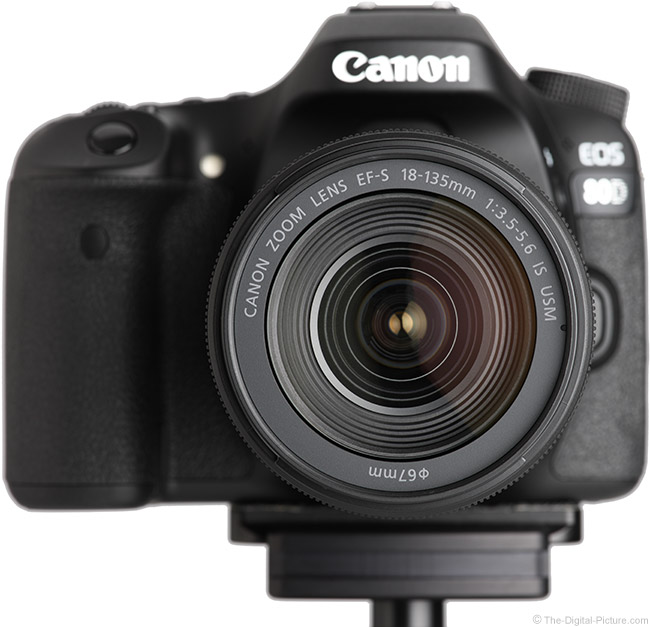
Prototype Quality
Epitome quality is always a top consideration for lens choice equally a lens is ordinarily the minimum cistron for prototype quality in current DSLR cameras. With the image-softening effects of diffraction beginning to show at apertures as wide as f/5.ix on the review-fourth dimension latest APS-C DSLRs (24 megapixel models), and becoming increasingly apparent as the aperture is stopped down, a "slow" lens' performance at its widest apertures becomes more paramount. Lenses ordinarily perform best at i or 2 stops narrower than their max apertures, merely ... we don't have much headroom with this (and other) slow lenses.
While overall lens image quality, particularly from a zoom lens, is very complicated, "sharpness", referring to contrast and resolution, is oft the main attribute photographers are interested in. This attribute potentially changes, minimally, with focal length, discontinuity and position in the image circle. What didn't change is this lens' optical design from the eighteen-135 STM predecessor.
With the light angle the least in the center of the image circle (center of the frame), this is where most lenses are at their best. At 18mm, the Catechism EF-S 18-135mm f/3.5-5.six IS USM Lens has good sharpness in the middle of the frame and loses little until the farthermost corners. Farthermost corners are moderately soft and improve as the discontinuity is stopped downward, though they never go totally sharp. Aside from the corners, stopping downwardly makes little departure in sharpness.
Wide open paradigm quality deteriorates somewhat through 35mm and 50mm, improves at 85mm and slightly declines again at 135mm, mostly noticeable mid-frame and in the corners. Extreme corners over again trail the center of the frame.
Following are some real earth images captured with a Canon EOS 80D DSLR camera. These are 100% resolution crops taken from images captured in RAW format and processed in DPP using the Standard Film Style with sharpness fix to "1" (very depression). The following examples are from the center of the frame.

In the centre of the frame, little difference in sharpness is accomplished by stopping downward. Stopping down 1/iii stop at 50mm is the biggest change in the above comparisons.
The following samples show the extreme top-left corner for 18mm and 50mm. The 135mm samples are from the bottom correct. in a properly adapted lens, image quality in all 4 corners should exist the same and this lens ig skilful in this regard. These but happen to be the corners I selected for illustration.

At 18mm, nosotros see major improvements as the aperture is narrowed. Notably absent in the 50mm corner crops is chromatic aberration – more virtually this presently.
Over again, these are farthermost corner examples. Image quality is notably meliorate deeper into the image circumvolve. Note that I omitted f/11 and narrower aperture examples from the above comparisons because they were not as sharp as the f/eight examples due to the effects of diffraction.
While it is not completely fair to compare a relatively low cost lens to a high terminate pro-form prime number lens, information technology is helpful to understand the image quality difference. To see what I'm referring to, compare the EF-S 18-135mm USM lens to the EF 200mm f/2L IS. These two lenses are not anywhere shut to each other in most regards including size, weight, toll, etc., but once again, it is helpful to see ideal prototype quality as a reference for what a lesser lens is delivering from the same camera.
Vignetting (peripheral shading) is rather well-controlled in this lens, at least well-controlled relative to other lenses used at their wide open up apertures. Await a modestly visible corporeality of corner shading, between 1 to 1.v stops, at wide open apertures. By f/8, vignetting is essentially gone. The clearing of peripheral shading can be seen in the corner crops shown in a higher place.
Also noticeable in the corner crops is lateral (or transverse) CA (Chromatic Aberration), the near easily recognized type of CA. Lateral CA shows as various wavelengths of light being magnified differently with the effect being increasingly noticeable toward the paradigm circumvolve periphery, causing the about-effected area of the image to appear less sharp due to misaligned colors. Expect for the strongest colour fringing along edges of strongly contrasting lines running tangential (meridional, correct angles to radii) near the corners of the frame, more often than not irrespective of the aperture used.
Zoom lenses, especially affordable ones, often accept LatCA and LatCA is generally worst at one or both ends of the focal length range. Following are three 100% crop examples taken from the top correct corner of Canon EOS 80D images.

The color misalignment is peculiarly potent at 18mm and noticeable at 135mm. The 50mm example shows how that LatCA is better-controlled in the mid focal length range. Fortunately, lateral CA is easily software corrected (often in the camera) by radially shifting the colors to coincide.
Axial CA and spherical aberration are not impacting issues for this lens. Potent color fringing is non seen at or near the indicate of focus in this subject that readily highlights these aberrations.

While not flare free, the 18-135 USM controls flare reasonably well. Every bit usual, the effects of flare become more than obvious when narrower apertures are used.
This lens has a noticeable amount of barrel distortion at the wide cease, causing subjects in the center of the frame to announced slightly enlarged relative to subject affair in the sides and corners of the frame. Much of the time this distortion will not be noticed, but if a straight line is running along the margins of the frame, the curvature volition be very apparent as shown in the 18mm example shown below.

This image is showing the full width of the lesser of an 18mm frame. To keep lines direct, zoom in to roughly 24mm where linear distortion is imperceptible. Zooming in further results in a transition to mild-to-moderate pincushion baloney throughout the balance of the focal length range.
A feature that DSLR cameras and lenses are desired for is their power to create a strongly blurred background. While this lens does not have the widest apertures bachelor, the telephoto focal lengths it has are long plenty to magnify the blurred backgrounds information technology does create – resulting in very potent blurs. I'll share a potent background blur sample film afterward (look for the butterfly), but volition address bokeh, the quality of that blur, now. Basically, this lens' blur quality is decent. Here are some samples of blurred specular highlights:

These results are not unusual and can vary with discontinuity, focus distance, subject distance and other factors.
With an aperture bract count of vii, distant betoken light sources showing a star-like event will have 14 points due to the odd vs. even number blade count. The points on these stars are coming from the blades of the discontinuity. Each blade is responsible, via diffraction, for creating 2 points of the star upshot. If the blades are bundled contrary of each other (an even blade count), the points on the stars volition equal the blade count as ii blades share in creating a single pair of points. The blades of an odd blade count aperture are not opposing and the issue is that each bract creates its own two points. Seven blades times two points each hateful 14-point star effects.
That said, creating stars from specular highlights is not a strength of this lens. Hither is a comparison with the Canon EF 24-70mm f/ii.8L II USM Lens (top-of-the-line, pro-class lens).

While this is not a completely apples-to-apples comparison, it closely approximates the real differences in results. The 18-135 creates some modest stars, just the 24-lxx goes star crazy.
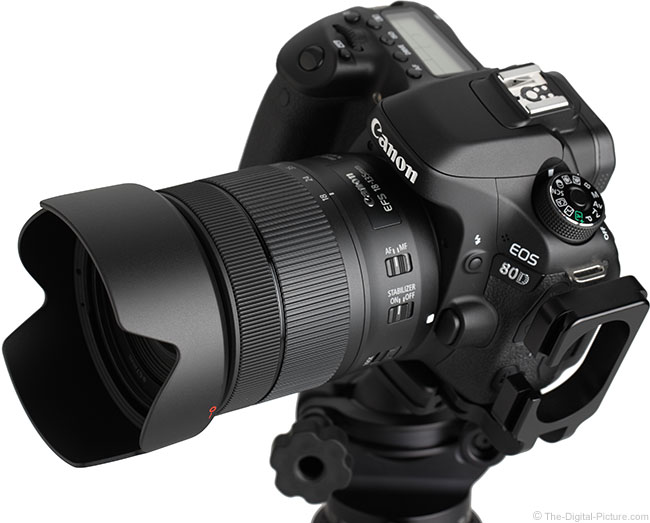
Focusing
The outset EF-S eighteen-135mm IS lens utilized a DC micro motor for AF drive, the then-current choice for economical lenses. This feature was directly targeted for upgrade by the 2d version of this lens, the EF-S eighteen-135mm IS STM. The STM (Stepping Motor) AF system provided very expert, though not really fast, autofocusing performance with other benefits included. 2 of the biggest benefits of the STM system were smoothness and quietness, both features that were highly desired for video recording.
While Ring USM remained Canon'due south preference for the review-time-latest high end lens designs, these lenses did not mostly focus and then smoothly in Movie Servo AF. While the review-time-latest Canon DSLRs are able to focus a Band USM lens with decent smoothness, these lenses nevertheless practice not focus as smoothly as the STM lenses and there is considerably more focus chatter sound during Film Servo AF.
Nano USM acts like heavily-caffeinated STM AF, combining the benefits of a high speed Ring USM actuator with the stepping motor's tranquility and smooth, direct, lead screw-type drive system. Like Ring USM driven AF systems, Nano USM focuses extremely fast. Like STM AF systems, Nano USM focuses almost silently, with only faint sounds heard with one's ear next to the lens. And, it focuses very smoothly.
Canon UsA.'due south Rudy Winston states: "Canon'south new Nano USM engineering science uses a completely different form factor, but achieves focus results within the lens via the aforementioned principles of ultrasonic vibration free energy, transmitted hither into linear (rather than rotational) motility inside the lens. This tiny new Ultrasonic motor achieves the combination of fast, nearly-instant response during nonetheless prototype shooting, with the smoothness required for good focus during video recording."
While the 18-135 STM was not a deadening-focusing lens, the 18-135 USM drives the focusing lens upward to four.3x faster at the telephoto end and ii.5x faster at wide bending end. [per Canon] I didn't feel the demand to scientifically verify these figures, simply mounting both lenses on cameras and switching back and forth between the two makes the focus speed difference quite noticeable.
Accuracy from the Catechism EF-S 18-135mm f/3.5-5.6 IS USM Lens has been excellent, both in I Shot and AI Servo modes. I can reliably count on this lens getting the focus altitude right (when I do my part properly of course). The AF operation from the get-go Nano USM lens predicts more than Nano USM lenses coming.

Like STM, Nano USM utilizes a focus-by-wire or electrical transmission focus design (vs. a directly gear-driven system). The transmission focus band electronically controls the focus of the lens. FTM (Full Time Manual) focusing is supported in AF mode with the camera in Ane Shot Drive Mode, but the shutter release must be half-pressed for the focus ring to get active. Note that FTM does not work if electronic manual focusing is disabled in the photographic camera's bill of fare (if this option is present). The lens' switch must be in the "MF" position and the camera meter must exist on/awake for conventional manual focusing to exist available.
The 18-135 USM lens' focus ring is very nicely-sized, ideally positioned (frontwards of the zoom band) and is smooth with no play. With electronics driving AF, the rate of focus change caused past the focus band can be variable, based on rotation speed, and that is the case with the xviii-135 USM. While we list 245° of focus ring rotation in the specs, a fast band turn will induce a much faster focus altitude change than a slow turn. It seems similar the focus distance barely changes when the ring is turned slowly, making prescise focus piece of cake – as long as the rate of plough remains abiding.
While I come across the advantages of the multi-speed AF ring, I found obtaining perfect focus altitude using my normal practice of rocking the focus ring back and forth to be somewhat frustrating. Using marked focus band pulls with lens this requires a skilful rate of turn, both in setup and execution of the pull. I would likely get used to this organisation and was quite successful in using it, only ... the focus ring seems to accept a heed of its own sometimes.
The first STM lenses went through an initialization process during power-up that involves the lens racking focus by some corporeality in both directions. This process caused me business concern when I had carefully setup a shot, waited for the right timing, woke upwards the photographic camera and watched my scene go temporarily out of focus. I adamant that the focus was returning to my previously gear up distance and no longer stressed at the initialization process, but ... amend is that this lens does not accept that aspect. The eighteen-135 USM's manual focus setting is non adjusted when the camera is awakened.
Manual focus adjustments are shine and centered with no unusual framing shift happening – alignment remains tight. With the camera powered off, this lens is dramatically far from being parfocal - the scene goes from in sharp focus to very strongly blurred by changing focal length. Ability the camera on and the lens makes an try to be parfocal, but my review lens was nonetheless non completely parfocal. Motion-picture show Servo and AI Servo AF modes will compensate for this alter automatically, simply otherwise, focus should be re-obtained afterwards a focal length modify.
No focus distance window or markings are provided, making at-a-glance focus distance checks not possible.
This is a rear-focusing AF system. The lens does not extend with focusing and the forepart filter threads do not rotate. Await some small subject size change in the frame when pulling focus using this lens.
Cameras featuring Hybrid or Dual Pixel CMOS AF and Film Servo AF make video recording very like shooting fish in a barrel and the STM lenses are very well-suited for this task. The smooth focusing makes focus distance transitions like shooting fish in a barrel on the viewer's optics and the sound of the lens focusing is not picked up by the camera'due south mic. Even the STM lens' aperture changes are quiet and smooth. This Nano USM AF implementation capitalizes on those strengths.
The Catechism EF-Due south 18-135mm f/three.5-5.half-dozen IS USM Lens' MFD (Minimum Focus Altitude) and the related MM (Maximum Magnification) remain unchanged from the STM predecessor. That is not a trouble as the 0.28x MM is an excellent spec among zoom lenses.
| Model | MFD | MM | |
| Canon EF-S 15-85mm f/three.5-v.six IS USM Lens | thirteen.viii" | (350mm) | 0.21x |
| Canon EF-Due south 17-55mm f/two.eight IS USM Lens | thirteen.viii" | (350mm) | 0.16x |
| Catechism EF-S eighteen-55mm f/three.5-5.six IS STM Lens | 9.viii" | (250mm) | 0.36x |
| Canon EF-Southward 18-135mm f/three.five-5.6 IS USM Lens | 15.4" | (390mm) | 0.28x |
| Catechism EF-Southward 18-135mm f/3.five-v.half-dozen IS STM Lens | 15.4" | (390mm) | 0.28x |
| Canon EF-S 18-135mm f/3.5-v.half-dozen IS Lens | 19.3" | (490mm) | 0.21x |
| Canon EF-S eighteen-200mm f/3.5-5.6 IS Lens | 17.7" | (450mm) | 0.24x |
| Canon EF 24-70mm f/two.8L Ii USM Lens | xv.0" | (380mm) | 0.21x |
| Canon EF 24-70mm f/4L IS USM Lens | 7.nine" | (200mm) | 0.70x |
One of the outset butterflies to arrive this spring, measuring about 1" (25mm) at its widest, is shown beneath in an uncropped image. This image was captured at 135mm at the MFD for this lens, showing also the MM.

Take find of the strongly blurred groundwork. The 135mm focal length combined with the wide open f/5.6 aperture and MFD represents this lens' ability to mistiness the background.
Maximum magnification specs increment and minimum focus distances decrease, as usual, with extension tubes in apply. The 18-135 USM's magnification range numbers with the Canon EF 12mm Extension Tube Ii in place are 0.43-0.09x and 0.61-0.21x with the Canon EF 25mm Extension Tube 2 in identify. Note that this lens may non be usable with extension tubes of combinations at the wider angle settings.
This lens is not compatible with Canon Extenders.

Build Quality & Features
The 18-135 STM was a nicely built, overnice-to-employ lens and the xviii-135 USM has received a chip of a makeover. Here are the two shown side-by-side.
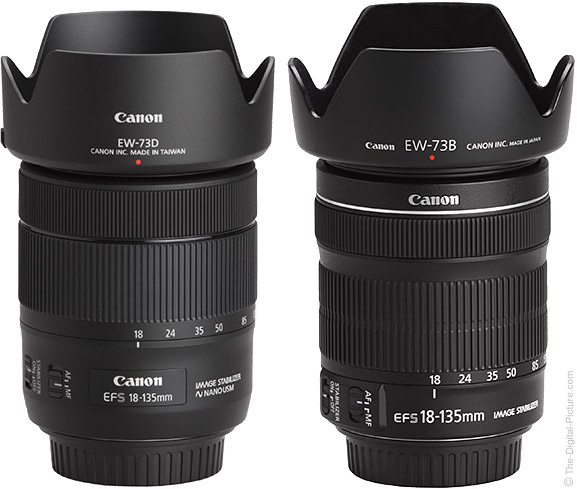
The USM version takes on a modernized appearance and loses the argent ring. Aided past a completely affluent-mount switch bank, the 18-135mm USM maintains a very even profile over much of the lens butt, making information technology comfortable to hold and easy to use.
This lens features a simple exterior that is primarily zoom and focus rings. The zoom ring has been shifted forward in position and reduced slightly in size to 1.28" from one.62" (32.5mm vs. 41.2mm). The manual focus ring has been increased in size slightly from 0.v" to 0.79" (12mm to 20mm) and has as well been moved forrard slightly. These rings are ideally positioned, accept ideal sizes, are smooth performance, accept no play and take a dainty rotational resistance/dampening.
Here is a closer look at the EF-S eighteen-135mm IS USM lens:

Like all of the other zoom lenses with a similar focal length range, the 18-135 USM extends with focal length increase (up to 1.95"/49.5mm). In that location is no play in the inner/extending lens barrel fifty-fifty at full extension. A lock switch is provided to retain the lens in fully retracted position (but), preventing gravity zooming. This was not an result on the review lens, just the switch is at that place if auto extension ever becomes present.

Normal for EF-S lenses is a quality plastic barrel and the 18-135 USM besides has this. The finish is attractive and the usual ribbed-safe-covered rings give the lens a quality experience.
While this is a nicely built lens, it is not one of Catechism's pro-class models. Notably missing is full weather sealing, including a lens mount gasket seal. Recommended is to keep this lens dry out.
Pocket-size and lite, especially for the focal length range, is a huge benefit of this lens. Here is a table comparison a variety of lens models:
| Model | Weight | Dimensions w/o Hood | Filter | Year | ||
| Canon EF-S 15-85mm f/3.five-v.6 IS USM Lens | twenty.3 oz | (575g) | iii.2 x 3.4" | (81.half dozen x 87.5mm) | 72mm | 2009 |
| Canon EF-Southward 17-55mm f/two.viii IS USM Lens | 22.8 oz | (645g) | 3.3 ten iv.4" | (83.5 x 110.6mm) | 77mm | 2006 |
| Canon EF-South 18-55mm f/iii.5-v.6 IS STM Lens | vii.ii oz | (205g) | ii.seven x iii.0" | (69.0 x 75.2mm) | 58mm | 2013 |
| Catechism EF-Southward 18-135mm f/iii.5-5.6 IS USM Lens | 18.2 oz | (515g) | iii.one ten 4.2" | (77.five ten 105.4mm) | 67mm | 2016 |
| Canon EF-South 18-135mm f/3.five-5.vi IS STM Lens | 16.9 oz | (480g) | three.0 x 3.8" | (76.6 x 96.0mm) | 67mm | 2012 |
| Canon EF-South 18-135mm f/iii.5-five.6 IS Lens | xvi.1 oz | (455g) | iii.0 x iv.0" | (75.four x 10.01mm) | 67mm | 2009 |
| Catechism EF-S eighteen-200mm f/three.5-5.6 IS Lens | 21 oz | (595g) | 3.1 x 4.0" | (78.6 x x.02mm) | 72mm | 2008 |
| Catechism EF 24-70mm f/2.8L Ii USM Lens | 28.four oz | (805g) | 3.5 10 four.4" | (88.5 x 113.0mm) | 82mm | 2012 |
| Canon EF 24-70mm f/4L IS USM Lens | 21.ii oz | (600g) | 3.3 x iii.seven" | (83.four 10 93.0mm) | 77mm | 2012 |
For many more comparisons, review the consummate Catechism EF-Due south 18-135mm f/3.5-5.6 IS USM Lens Specifications using the site's Lens Spec tool.
Seeing the size difference is ever nice for those of us who are strongly visually-oriented (photographers in full general). Here is a comparison prototype featuring a option of Canon EF-Southward lenses:
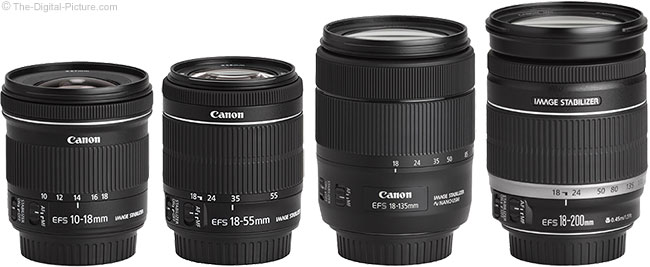
Positioned to a higher place from left to right are the post-obit lenses:
Canon EF-Southward 10-18mm IS STM Lens
Canon EF-South 18-55mm f/3.five-5.6 IS STM Lens
Canon EF-Due south eighteen-135mm f/three.5-5.6 IS USM Lens
Catechism EF-Southward 18-200mm f/3.5-5.half dozen IS Lens
The same lenses are shown below, extended with their hoods in place.

Use the site's product prototype comparison tool to visually compare the Catechism EF-Due south xviii-135mm IS USM Lens to other lenses.
The eighteen-135 USM accepts 67mm threaded filters. These moderate-in-size filters are rather mutual for Canon lenses and non too pricey. I recommend using slim model filters such as the B+W XS-Pro line for this lens as standard thickness filters may create some mechanical vignetting at the broad terminate of the focal length range.
The optional petal-shaped Catechism EW-73D Lens Hood is relatively meaty, simply is large plenty to provide reasonable protection for the front lens element. The lens hood protects from both impact and from bright light (particularly the sun) that can reduce image contrast. Every bit with almost of Canon's recently introduced lens hoods, this one has a jump-loaded release button that allows the hood to remain locked in position even so easily installed or removed as desired. With the hood installed, expect a camera's built-in wink to be partially blocked (lens hood shadow in frame) at the wider angles (this lens does not block the built-in wink with no hood installed).
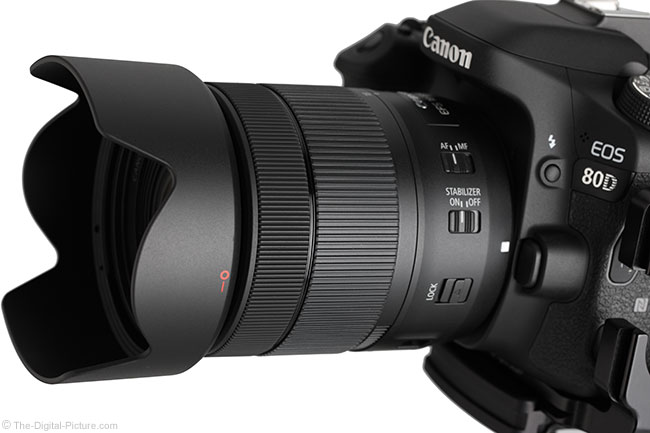
While I nearly always recommend using a lens hood, the price of this matte black plastic (interior and exterior) hood seems high. Canon should have included this one in the box as the U.Due south.A. press release hinted.
The Canon LP1116 soft drawstring lens pouch is also optional for this lens. These pouches offer only low-cal impact protection from the side with more than substantial bottom padding provided. Cases such as the Lowepro Lens Cases offer better protection for private storage (and a lower price).

Another starting time that the Canon EF-South 18-135mm f/3.5-v.half-dozen IS USM Lens delivers is compatibility with the aforementioned-time-introduced Catechism Ability Zoom Adapter PZ-E1.

The PZ-E1 attaches to the bottom of the lens (see mountain and electronic contacts above) and via a gear that interlocks with the groves in the zoom band, providing silent electronic zoom command, including remotely from a Canon app. The zoom speed is adjustable, ranging from 2.four sec up to xiv seconds for a total extents zoom change.

Toll and Value
The Canon EF-South 18-135mm f/3.5-5.6 IS USM Lens hit the streets with a price tag modestly higher than its STM predecessor's same-time-current toll. The 18-135 USM is a practiced lens and this price makes it a decent value. Where the STM version became a actually good value was in a kit with a DSLR camera (we have also posted some fantabulous deals for this lens). The 18-135mm USM was introduced simultaneously with the Canon EOS 80D and is available with that camera in a kit. However, there is (initially) no discount for ownership the two together. Sentry for that to change.
Canon'southward standard warranty is 1 twelvemonth. While this duration is among the shortest in the industry, my Catechism gear seldom needs serviced. And, Canon's service and customer back up is among the best available.
The reviewed eighteen-135mm USM lens was online retail sourced.

Alternatives to the Canon EF-S eighteen-135mm IS USM Lens
With the general purpose lens being such a large one, consumers take a lot of choices. For many, the decision to buy the EF-S 18-135 IS USM will exist weighed confronting the EF-Due south eighteen-55mm IS kit lens available at the time. At review fourth dimension, that lens is the Canon EF-South xviii-55mm f/3.5-5.6 IS STM Lens. The 18-55 has the low toll, small size and light weight reward, but the eighteen-135 USM has a much longer focal length range and faster/ameliorate AF system. These 2 lenses are simiarly sharp until the long end of the 18-55's range is reached, where the 18-135 has the advantage.
Though I expect the Catechism EF-S xviii-135mm f/3.5-5.six IS STM Lens to be phased out of production, this lens is very like to the eighteen-135 USM. Nano Ring USM is the USM version's primary advantage and modestly lower cost is the STM'due south reward.
For those looking for a long focal length range, the Canon EF-Due south 18-200mm f/3.five-5.6 IS Lens will be some other consideration. The 200mm long end of that range is very noticeably longer than 135mm. At 8 years of historic period, the 18-200 is starting to show signs of historic period. This lens was skipped over (as of review time) for the STM AF handling and the 18-135 now has the adjacent improved AF system, Nano Ring USM, to its strong advantage. The xviii-135 is a sharper lens overall and would usually be my selection over the 18-200.

Summary
While my kit is comprised of mostly pro-class lenses, I have an 18-135mm STM lens in it and will mount that lens on occasion. That the USM version is a pregnant upgrade from an auto focus system perspective, it represents an even more valuable member in a kit.
This is a pocket-sized, calorie-free and reasonably-priced lens with constructive image stabilization and a great general purpose focal length range. Combining the best aspects of USM and STM focusing technology, this lens represents an equally compelling pick for both still photo and video needs.
Bringing you this site is my full-time job (typically sixty-80 hours per calendar week). Thus, I depend solely on the commissions received from yous using the links on this site to make any buy. I am grateful for your support! - Bryan
My Recommended Canon EF-S 18-135mm f/3.5-5.6 IS USM Lens Retailers
Rent the Canon EF-S 18-135mm f/3.5-five.half-dozen IS USM Lens
The Tip Jar
More Canon EF-S eighteen-135mm f/3.5-5.six IS USM Lens Related Data
Bryan Recommends Buying It Hither
Source: https://www.the-digital-picture.com/Reviews/Canon-EF-S-18-135mm-f-3.5-5.6-IS-USM-Lens.aspx
0 Response to "Youtube Canon Ef 24105 F3556 Is Lens Review"
Enregistrer un commentaire